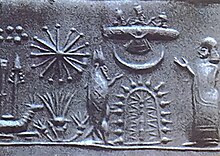Abgal

The Abgal ( Sumerian for “wise lord”, Akkadian Apkallu , NUN.ME) are seven Sumerian gods of protection and wisdom who were invoked especially in healing magic.
history
The Abgal were the "seven wise men before the flood" created by Enki (Akkadian: Ea) to bring civilization to the people. A text from Uruk lists the antediluvian kings and the seven antediluvian sages: U-An, U-An-dugga, Enmedugga, Enmegalamma, Enmebulugga, An-Enlilda and Utuabzu. Each of these abgal had its own role. They stood for fire, medicine, law, handicraft and art. These Abgal merged with the Akkadian Apkallu to form Babylonian protective demons. A reference to these seven wise men can also be found in the Erra epic , Plate I 162, where they are called puddu fish.
Afterlife
U-An is often identified with Berossos ' culture bringer Oannes .
According to Werhahn-Strauch, an adaptation of the legend can be found in the seven Saptarishis from the Atharvaveda , who survived the flood together with Manu in a boat that was pulled by Vishnu in his incarnation as a Rohita fish . This goes back to speculations by Friedrich Creuzer .
iconography
Traditionally, the Abgal are represented half as fish, half as humans or as people in fish costumes. You were probably the godfather of other mythological figures such as Dagān or Triton . But there are Babylonian incantation texts that describe other forms of Apkallu. In an evocation against diseases it is said, for example, B .:
“Place seven wooden apkallu at the head of the patient.
Bury seven clay bird apkallu on a wall that adjoins another room.
Bury the seven clay fish apkallu in front of and behind the chair.
Accordingly, especially in the late Babylonian, but above all the Assyrian period, there were more and more different forms of apkallu, human, fish, bird and bull. The bird apkallu from the palace in Nimrud are famous . However, it is partly controversial whether the depictions show Apkallu or other prey demons.
See also
The Abgal should not be confused with the Palmyrenian equestrian god Abgal with his companions Maʾan or Ašar .
literature
- Jonas C. Greenfield : Apkallu. in: Pieter Willem van der Horst, Karel van der Toorn, Bob Becking (eds.): Dictionary of deities and demons in the Bible . Brill, Leiden 1999.
- Gerhard J. Bellinger : Knaurs Lexikon der Mythologie , Droemer Knaur Verlag, Munich, 1989, ISBN 3-8289-4155-9
- Dietz-Otto Edzard and a .: Real Lexicon of Assyriology and Near Eastern Archeology , Vol. 8 . de Gruyter, Berlin 1997, ISBN 3-1101-4809-9
- Wiggermann, FAM: Mesopotamian protective spirits: The ritual texts . Cuneiform monographs 1. Styx Publications, Groningen 1997. ISBN 9072371526 .
Web links
Illustration of the Apkallu (No. 9)
Individual evidence
- ↑ Rykle Borger, The Summoning Series Bīt mēseri and the Ascension of Enoch. Journal of Near Eastern Studies 33/2, 1974, 184
- ↑ a b Rykle Borger, The Summoning Series Bīt mēseri and the Ascension of Enoch. Journal of Near Eastern Studies 33/2, 1974, 186
- ^ Werhahn-Strauch, L .: Christian fish symbolism from the beginning to the high Middle Ages . Zeitschrift für Kunstgeschichte 35, 1972 Munich, Berlin, p. 1f
- ↑ Georg Friedrich Creuzer, Symbolism and Mythology of the Ancient Peoples, especially the Greeks, Leipzig and Darmstadt, Carl Wilhelm Leske Verlag 1812
- ↑ van der Horst 1999, p. 74.
- ↑ Wiggermann 1997, p. 42ff
